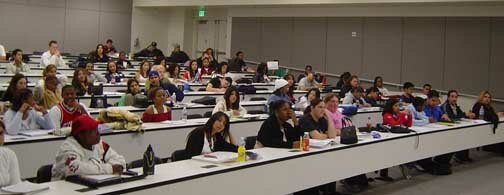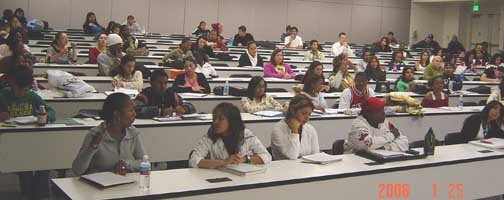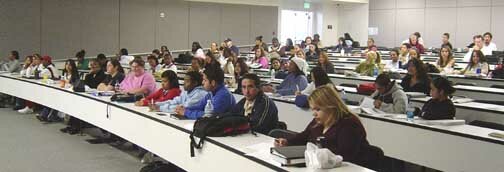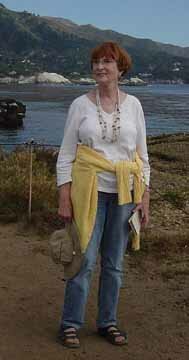BIO 102 MENU
syllabus 
1 - origin 
2 - biomol. 
3 - biomol2 
4 - viruses
5 - prokaryon 
6 - endosym 
7 - eukaryon 
8 - energy 
9 - mitosis 
10 - meiosis 
11 - reprod 
12 - genetics 
13 - humgene 
14 - humge2 
15 - evolution 
16 - evolutio2 
17 - diversity 
18 - diversi2 
19 - tissues 
20 -digestive 
21 - respirat 
22 - circul 
23 - excret 
24 - endocr 
25 - receptors 
26 - nervsys 
Quizzes
Bio 103 Lab 
(full title of lecture appears in status bar on the top or at the bottom of your window)
Biology 102-01 General Biology Lecture
Syllabus - Spring 2006
|
Instructor: |
Carol D. Guzé, Ph.D. |
|
|
Office: |
||
|
Telephone: |
(Bio Office) |
|
|
Lecture Room |
WH D165 |
|
|
E-mail: |
||
|
Office Hours: |
Mon 1:00 - 4:00 p.m. |
|
|
Website: |
||
|
Teaching Assistant: |
TBA |



Bio 102-01 Class Spring 2006

DR.CAROL GUZE
TEXT:
BIOLOGY: Concepts and Applications, 6th edition, by Cecie Starr.
Obtain a text and the CD-ROM. If you do not own a computer, you can use the student computer lab. The disk and your text have self-quizzes with answers (see answers in the Appendix). I may select questions for your weekly quizzes and exams from these quizzes. Also, be sure to use the Index and Appendices in the back of the text. Use the Glossary of Biological Terms, it will be of immense value.
SCANTRONS:
You will need only one scantron for the entire semester for the weekly quizzes. You could buy a pack with other students in the class and share them.
LIBERAL STUDIES MAJORS:
If you plan to teach, we encourage you to sign up for the Bio 103 laboratory section 07 on Wednesday 5:30 to 8:15 p.m. This lab is designed specifically for you and it is taught by an experienced teacher who is a graduate of the Biology Master's degree program.
TUTORING:
If you come to the instructor's office hours beginning in the first week of classes you will have the best chance for making a good grade in this course. You will get personal assistance and advise on how to study for this course.
The Center for Learning and Academic Support Services (C.L.A.S.S.) (http://www.csudh.edu/class) provides tutoring in a number of subjects including biology and offers computer use facilities as well. CLASS is located in SCC 11-311, CLASS II 11-325 and CLASS Annex LCH A-222. It also provides a comfortable learning and studying environment where students can ask questions and receive academic support. While tutors can help you, remember that you will be much better served by discussing any difficult areas with the professor.
Classroom Etiquette
All cell phones must be turned completely off in the classroom...and not set to vibrate.
Asking questions of the professor during lecture is encouraged but any other talking is inappropriate. If you arrive late, find a seat quickly and quietly. The classroom doors will be closed 15 minutes after class starts and may be locked . If you must leave early, notify the professor at the beginning of class and find a seat on the aisle so you do not disturb others when you leave. Take care of any of your needs before you come to class because if you leave the room before class is over you may not return.
Lecture Topics & Chapters in the Text
I. The Cellular Basis of Life |
||
|
The Origin of Life on Earth |
18, 1 |
|
|
Biomolecules: Are You What You Eat? |
1, 2, 3 |
|
|
DNA—RNA--Protein |
12, 13, |
|
|
Viruses, Cells and Cell Organelles |
4, 19 |
|
|
Antibiotic Resistance |
30, 34 and see page entries listed in the Index |
|
|
Metabolism and Energy Production |
5, 6, 7 Appendix V |
|
II. Principles of Inheritance and Development |
||
|
Cell Division: Like Begets |
8, 9 |
|
|
Human Reproduction and Development |
38 |
|
|
Mendelian Genetics |
10 (answers are in Appendix IV) |
|
|
Genes, Chromosomes and Mutations |
11 |
|
|
Human Genetics |
11 (Answers are in Appendix IV) |
|
III. Principles of Evolution &
|
||
|
Evidence and Mechanisms of Evolution |
16, 17, 18 |
|
|
The Five Kingdoms |
Appendix I |
|
|
Viruses, Bacteria |
19 |
|
|
Protists |
20 |
|
|
Fungi |
20 |
|
|
Plants |
21 |
|
|
Animals: Invertebrates and Vertebrates.... |
22, 23 |
|
V. Animal Structure and Function:
|
||
|
Tissues, Organs, Systems |
28, 32 |
|
|
Protection, Support and Movement |
32 |
|
|
Nutrition-Digestive System |
36 |
|
|
Gas Exchange-Respiratory System |
35 |
|
|
Circulatory System-Immune System |
33, 34 |
|
|
Excretory System |
37 |
|
|
Coordination: |
29, 30, 31 |
|
Midterm
Wednesday, March 22, 2006 4:00 to 5:15 p.m.
Final Exam
Monday, May 15, 2006 4:00 - 6:00 p.m.
Evaluation
|
Weekly quizzes |
120 points |
|
|
Midterm exam |
120 points |
|
|
Final exam |
120 points |
|
|
TOTAL |
360 POINTS |
Quizzes and exams are mandatory. Make-up exams or quizzes will be given only if prearranged. You may want to obtain a copy of any missed quiz for purposes of studying for the exams. The past quizzes are posted on this web site (see side bar). Examination and quiz questions will focus on lecture material but may also include questions from the assigned text. Be sure to able to answer the questions at the end of each chapter.
Grade Assignments
|
A B+ C+ D+ F |
100 - 92 % 89 - 87 % 79 - 77 % 69 - 66 % < 60 % |
Course Objectives
(These objectives will be assessed by examinations)
By the end of the course you should be able to:
- 1. Describe the cellular basis of life and the structure and function of the major cellular organelles
- 2. Describe the structure and function of the biomolecules used in the construction of all cells
- 3. Explain the nature of viruses, how they differ from cells and why antibiotics do not control them
- 4. Explain the nature of the genetic material (DNA) and how it replicates, stores and transmits information
- 5. Explain how new organisms are produced sexually and how they develop from a fertilized egg.
- 6. Describe the five Kingdoms of organisms and the major animal and vertebrate groups
- 7. Describe the function and structure of the major organ systems in animals and humans.
Academic Integrity
It is essential that you read those pages in the University Catalog explaining, Academic Integrity: Its Place in the University Community.
It explains academic integrity and the nature of academic dishonesty. It also describes the role of the faculty and student in promoting academic integrity.
In addition it explains the University policies and procedures for dealing with questions of academic dishonesty.
Suggestions for Studying
Print out the web lectures using the landscape (not portrait) page set up. Read over the notes before class and use the print out to take notes during the class. Be sure you can identify the main ideas in each paragraph. After class make note cards for the new vocabulary and concepts you encountered in the lecture and the lecture notes. Be sure to come to office hours to go over anything you do not understand or if you would like further explanation. You may also prepare questions to ask during the following lecture or during office hours. This is an excellent way to study for the weekly quizzes. You can also earn extra points by answering questions during lecture or when you find an error in the lecture web notes.

